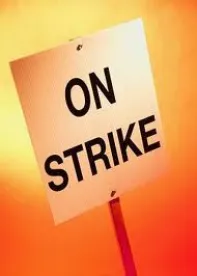In the waning days of the Obama Administration, the President’s appointed General Counsel to the NLRB took official action this week to sanction questionable and disruptive strike activity, including one day strikes that are frequently used by aggressive unions against hospitals and other employers. Specifically, the GC’s Office issued an Operations-Management Memorandum acknowledging unions and employees “are more frequently engaging in short-term strikes” and seeking to “clarify and modify the law regarding intermittent and partial strikes” to address concern employees face “potential discipline for activities that should be considered protected under Section 7 of the Act.”
The Memo seems to be a transparent attempt to push an agenda to protect the activities of certain unions, mainly in the healthcare, fast food and retail industries which have used multiple one-day strikes as a weapon.
Intermittent Strikes, Partial Strikes and Slowdown Are Not Permitted Under the NLRA
Under current National Labor Relations Act case law work slowdowns, partial strikes and intermittent strikes are not permitted, and therefore employees who engage in them are not protected and may potentially be disciplined or discharged. The reason for this long standing policy is clear; while employees should be free to withhold their labor as economic leverage, they should not be able to do so without any risk or sacrifice. For that reason, what the Board has historically referred to as quasi-strikes which are “intentionally planned and coordinated so as to effectively reap the benefit of a continuous strike action without assuming the economic risks associated with a continuous forthright strike, i.e., loss of wages and possible replacement,” have not been entitled to protection under the Act. WestPac Electric, 321 NLRB 1322, 1360 (1996).
While this principle is sound and well established, its exact contours lack clarity. While work slowdowns, partial day strikes or work stoppages refusing to do a certain type of work (overtime, weekend, etc.) fall clearly outside the protection of the Act, to date Board law has been less clear on strikes lasting at least one day, even if repeated in nature. While most recognize that an announced strategy of multiple one day strikes would be problematic as would many one day strikes, there has been less clarity on how many is many, with many believing two to three one day strikes could be protected but more than that likely loses protection.
Unions Increasingly Use Intermittent and Short Strikes to Improperly Gain Bargaining Leverage
In recent years , taking advantage of the lack of clarity, the California Nurses Association, SEIU, and other unions have used one day strikes against hospitals as a way to force the target hospital to spend millions of dollars in replacement workers and other preparations to ensure proper care for their sick patients while not really impacting the wages of the nurses or other healthcare workers who only lose a day or two of pay. Similarly, the UFCW, “Fight for 15” and other organizations have used flash strikes or other short term walkouts (often during holidays or other peak times) to obtain publicity and disrupt the operations of fast food restaurants, Wal-Mart and others, without significant or even any loss of wages.
In the case of a hospital, these strikes typically take the form of a strike notice under 8(g) of the Act telling the hospital that the employees will be on strike for a single 24 hour period together with an unconditionally offer to return to work as the end of that period. This forces the hospital to scramble to find qualified temporary replacement workers, vet them, train them and orient them. In order to do so, the hospital typically needs to contract with the replacement workers for at least five days and at significant expense. Once the strike is over, often nothing has been resolved and the parties go back to the table only for the union to threaten to engage in another intermittent strike sometime down the line.
The only saving grace was that unions were hesitant to call more than two or three of these short strikes during any single labor dispute/negotiation because of the lack of clarity noted above left them vulnerable to a claim that the third or fourth short strike was intermittent and unprotected.
GC Seeks an Exception
In acknowledging both the increase of these union tactics and the lack of clear guidance on them, the GC’s Memorandum instructs the NLRB’s Regions to take action to again put their thumb on the scales in favor of unions. Specifically, the GC Memorandum provided and instructed Regions to utilize an Intermittent Strike Brief Insert that advocates for a loosing of the standard to sanction any intermittent or short time strikes which:
-
“involve a complete cessation of work [as opposed to a slow down or partial work stoppage];
-
“are not designed to impose permanent conditions of work [i.e., weekend only strikes, refusal to work overtime, etc.], but rather are designed to exert economic pressure; and
-
The employer is made aware of the employees’ purpose in striking.”
While, if accepted by the Board and the courts, this certainly would provide some clarity, that clarity would be that unions would be free to conduct as many short, intermittent strikes as they desired so long as they called for a complete walkout and they old the employer what they were seeking. This would not only sanction the damaging work stoppage above, but would result in increased and expanded use/abuse of such tactics.
Management Missive
Employers must be aware of this development, as well as the fact unions likely will be looking to test this theory, and should prepare accordingly. While certainly contingency planning is a must, employers may also be able to take advantage of certain bargaining strategies designed to mitigate the impact of these union tactics. Employers should consult with experienced labor counsel to ensure they are prepared.



 />i
/>i

